October, 2015
Spectacular Spiders of the Sunshine State
by Valerie
By a serendipitous set of circumstances, I have suddenly become an arachnophile. Certainly not from my standpoint, but people seem to think that just because I have authored a small pocket guide about spiders, I love them. Not so. I love my sister, my husband, my dog. I also love music, art, visiting with my friends, taking photographs, and going on long strolls in gorgeous places. Just because someone writes about, say, chiggers and wood ticks, it is almost certainly not because they love, or even like, them. You needn't feel emotional attachment to anything for it to be interesting. I'm sometimes asked, after presenting a program about insects, which is my favorite kind. I have to honestly answer, "I don't have one." To my list of things I adore, I guess I have to add "intellectual stimulation." The old cliché "Variety is the spice of life" hits a chord in my heart. I would rather be delving into the "how and why" of the world around us than savoring the best meal in the world. Deciphering the mysteries of life on Earth, from my own miniscule perspective, is a passion. I love learning.
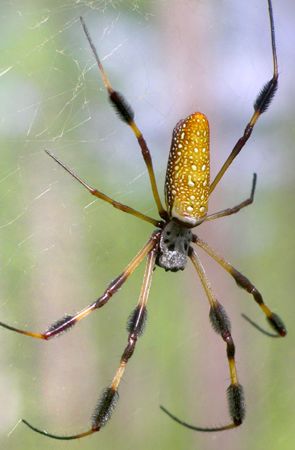 That said, I DO like to study spiders, along with myriad other creatures I see around me. I would be just as happy creating a pocket guide to land snails or beetles, but I was asked to do one on spiders because they are a more popular topic with the general public. And I bet it is not because anyone really LOVES them!
That said, I DO like to study spiders, along with myriad other creatures I see around me. I would be just as happy creating a pocket guide to land snails or beetles, but I was asked to do one on spiders because they are a more popular topic with the general public. And I bet it is not because anyone really LOVES them!
The spiders in Texas are fascinating, but there is always the allure of the exotic, and Florida provides me with a not-too-distant destination for the discovery of different things. The convenience of having family only one long day's drive away in a tropical climate that compares to Central America (minus the infamous diseases) is certainly appealing. Another big plus is the state's support of parks, preserves and waterways. With an economy dependent on tourism, Florida spends the money to keep natural areas protected and yet accessible, with well-kept infrastructure necessities like trails, boardwalks, informative signs and support buildings. All this makes it both enjoyable and expedient to study the wildlife found on this unique peninsula, with its diverse landscape, vegetation and habitats.
Perhaps the most conspicuous Florida spider is the gargantuan Golden-silk Orbweaver (Nephila clavipes). Not only is the spider large, but it creates enormous orb webs, sometimes spanning more than 10 feet, in highly visible places; this beast is hard to miss! Even the most casual visitor to any park that has trees, and they all do, cannot help but notice the iridescent glimmer of the yellow colored silk as it catches the leaf-filtered sunlight. All these huge spiders are female. The males are much smaller and tend to be seen only when they are at the edges of a female's web, waiting for their chance to approach and mate with her.
Whenever I visit Florida , it's fun to observe the Golden-silk Orbweavers in their webs but I also remember a time when I felt much less tolerant towards them. Decades ago, when I was a teenager, our family took a canoe trip in the Everglades. One of the most impressive memories I retain from that singular adventure was of the vultures, disturbed by our presence, flying from their tree branch perches and knocking the bulky, leggy spiders out of their canal-spanning webs and straight into our canoe. There's a nightmare image worthy of an overactive imagination, but it really happened!
Very few orbweavers in Florida are truly big. In fact, some of the prettiest species are on the small side and, even with their distinctive webs, not that easy to find. The Triangulate Orbweaver (Verrucosa arenata) is a medium-sized spider with a very distinctive shape. Like many related species, it's abdomen is a rounded shape with a point at the back end. The top side, however, is marked by an attention grabbing yellow or white triangle. The triangle often has a flat side up and the point down because, unlike most other orbweavers, this spider usually sits in the middle of its web with its head facing upwards instead of down.
Decorations on the abdomen are one way that orbweavers appear less like appetizing spider snacks to foraging birds. Sharp, hard spines sticking out would certainly make anything a bit harder to swallow. The Spiny-backed Orbweaver (Gasteracantha cancriformis) looks somewhat like a crab because of its squat shape and those distinctive spikes. In Texas, this species has black spines and the top of the abdomen can be white, yellow or orange. In Florida, they are almost always white with red spines. The webs of these spiders are easy to recognize because they are larger than usual for that size occupant, have white tufts spaced around the edge, and tend to have very tight spiral silk, resembling the closely spaced groove on an old phonograph record.
Carrying the spine idea even further, the Arrow-shaped Micrathena (Micrathena sagitatta) has two big spikes sticking out the rear end. This small spider is another with gaudy colors and a shiny surface. They look like they are made out of plastic. Webs of this species are on the small side and often not easily noticed within the leaves of shrubs.
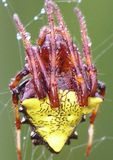
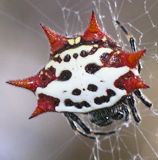
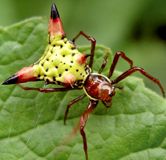
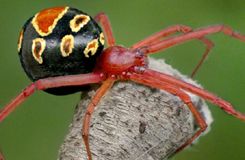
Other kinds of webs are not as beautiful as those produced by the orbweavers. The venomous widows create tangled cobwebs which are efficient for catching prey but not much to look at. As the state's only spiders with medically significant venom, the Black, Brown, and Red Widows garner more than their share of attention. By the way, the Brown Recluse, so common in several states centering on Arkansas, is not native to Florida except for the extreme west tip of the panhandle; the species only occasionally arrives in freight or belongings that have been moved from its native range and no established populations have yet been found in the peninsula.
So, back to widows. The Southern Black Widow (Latrodectrus mactans) can be found by looking under logs or in thick vegetation, while the very common Brown Widow (Latrodectus geometricus) is rather easy to find around homes, such as under siding and in corners. The most beautiful species of the group is the Red Widow (Latrodectus bishopi), which is only found in the scrub habitat of central and southern Florida. It can be found in low-growing palm and palmetto leaves. Bites from all of these timid spiders are rare, but the venom contains a neurotoxin that is up to 20 times more potent than that of rattlesnakes. Luckily, the small size of the spiders limits the amount of venom that can be delivered so fatalities occur in only a fraction of cases.
One very distinctive and common Florida spider took me years to find. Part of the reason is that I only visit occasionally and for just a week or two at a time. I had heard about the small Blacktailed Red Sheetweaver (Florinda coccinea) and certainly wanted to find this tiny gem. It can be very common in low grass, of which there is certainly plenty, but I was just never sure of exactly what to look for. The size of the spiders is miniscule: only a few millimeters in length, and their webs are small and close to the ground. I knew that the red color of the animals should stand out, but wasn't sure I could spot such tiny dots in a sea of grass. My luck changed one day in May at the Moss Bluff lock on the Ocklawaha River. It was a humid morning and, where the mowed grass ended near the taller water's edge vegetation, there were numerous small webs adorned with dew droplets. Under most of these little webs were tiny red spiders, barely visible even when the sun hit them. A half hour spent lying on the wet grass to photograph the undisturbed web inhabitants yielded my first images of these gaudy little creatures.
Not all spiders make webs, of course. Loads of them, including wolf, lynx, crab, ghost and fishing spiders, hunt either by stalking or ambush. One of the best known of these groups is that of the jumping spiders. Tiny, fuzzy and relatively short-legged, jumping spiders have perhaps the best eyesight of any arthropod. The biggest pair of their front-facing eyes can distinguish fine details and track movement at quite a distance for a creature that rarely reaches a half inch in length. Most jumping spiders are less than a fourth of an inch.

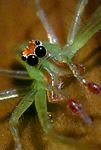
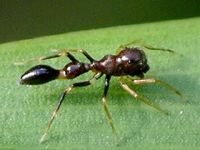
Many of Florida's jumping spiders are rather typical looking and, while often sporting handsome colors, do not really stand out from the arachnological crowd. One common species, though, does: the Magnolia Green Jumper (Lyssomanes viridis). This miniscule translucent emerald spider can often be found in and around broad-leafed trees, but it is hard to see on the foliage. I usually find them on wooden structures such as railings or fence posts, where their color certainly does not camouflage them. Due to the way their large compound eyes reflect light, they appear green when the spider looks away but turn black when it is staring straight at you. The males of this species are especially attractive as they have a red cap on their head that boldly contrasts with their bright apple green body.
Another decidedly different looking jumper does not stand out by way of color but by its shape. This is an Ant-mimic Jumper (Synemosyna formica), one of several such tricksters that look just like ants. Most people think that a jumping spider would be more dangerous than an ant, but in the tiny arthropod world, ants are considerably better protected and more often conspicuously absent from the menu of predators. Ants are social and so enjoy the protection of numbers, they have strong jaws that bite hard, and most contain formic acid in their bodies that makes them distasteful. 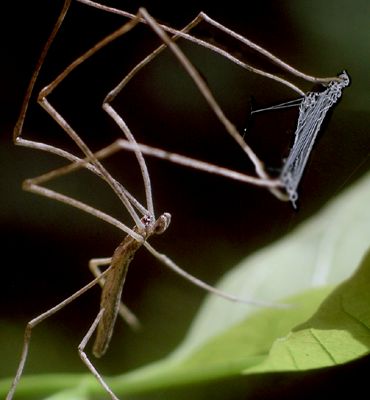 A good number can sting and they frequently exhibit very aggressive behaviors. Jumping spiders, on the other hand, are loners without stings or chemical protection. Not only do ant-mimicking jumping spiders look like ants, but they move about in very ant-like ways, including the avoidance of actual jumping. While using one pair of legs to imitate antennae (which spiders do not have), ant mimics usually dart about in the same way as real ants. One of the few times they break character is when they are courting a female (males of many animal species throw all caution to the wind when sex is involved).
A good number can sting and they frequently exhibit very aggressive behaviors. Jumping spiders, on the other hand, are loners without stings or chemical protection. Not only do ant-mimicking jumping spiders look like ants, but they move about in very ant-like ways, including the avoidance of actual jumping. While using one pair of legs to imitate antennae (which spiders do not have), ant mimics usually dart about in the same way as real ants. One of the few times they break character is when they are courting a female (males of many animal species throw all caution to the wind when sex is involved).
This little sampling of Florida spiders simply must include a species that I find exceptionally fascinating. The Ogrefaced Spider (Deinopis spinosa) is long-legged and dull colored. I remember reading about this creature many years ago in a nature magazine and seeing a photo of its odd looking face. The grotesque frontal aspect, though, is not what makes this spider special; its hunting technique is the real curiosity. During the day, the spider hides stretched out along a twig. But at night, it creates a small net-like web and holds it between its front four legs. The next step is to wait in vegetation until prey walks by, at which point the spider snaps the web down upon the unsuspecting victim, which gets tangled up in the silk. This kind of hunting requires excellent vision and the Ogrefaced Spider has that, but only at night. Its huge front-facing eyes, which are similar in appearance to those of jumping spiders, are sensitive in the dark but virtually blind in sunlight.
There is a popular saying amongst educators who discuss arthropods: "You are never more than two feet from a spider." This is a reflection of the fact that most spiders, as well as insects, are so tiny that we never see them. But they are also ubiquitous in almost all terrestrial habitats. There is a reason that cobwebs form as if by magic in houses. There isn't really magic, but there are LOTS of terribly tiny spiders that leave their silk behind. Though the myriad miniscule spiders are not all that interesting, the more unusual examples are fun to examine. It is a rare person who actually loves spiders, but almost anybody can appreciate the elegant adaptations and survival strategies of these remarkable animals.
 That said, I DO like to study spiders, along with myriad other creatures I see around me. I would be just as happy creating a pocket guide to land snails or beetles, but I was asked to do one on spiders because they are a more popular topic with the general public. And I bet it is not because anyone really LOVES them!
That said, I DO like to study spiders, along with myriad other creatures I see around me. I would be just as happy creating a pocket guide to land snails or beetles, but I was asked to do one on spiders because they are a more popular topic with the general public. And I bet it is not because anyone really LOVES them!







 A good number can sting and they frequently exhibit very aggressive behaviors. Jumping spiders, on the other hand, are loners without stings or chemical protection. Not only do ant-mimicking jumping spiders look like ants, but they move about in very ant-like ways, including the avoidance of actual jumping. While using one pair of legs to imitate antennae (which spiders do not have), ant mimics usually dart about in the same way as real ants. One of the few times they break character is when they are courting a female (males of many animal species throw all caution to the wind when sex is involved).
A good number can sting and they frequently exhibit very aggressive behaviors. Jumping spiders, on the other hand, are loners without stings or chemical protection. Not only do ant-mimicking jumping spiders look like ants, but they move about in very ant-like ways, including the avoidance of actual jumping. While using one pair of legs to imitate antennae (which spiders do not have), ant mimics usually dart about in the same way as real ants. One of the few times they break character is when they are courting a female (males of many animal species throw all caution to the wind when sex is involved).